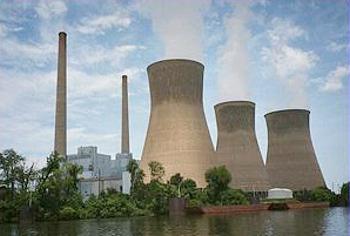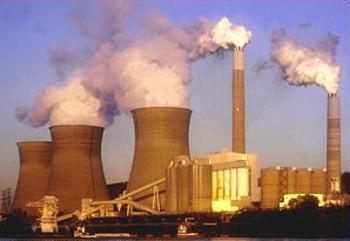White House Undercuts Coal Power Plant Water Pollution Rule
WASHINGTON, DC, July 24, 2013 (ENS) – Coal-fired power plants, many operating with expired permits, have become the largest source of toxic water pollution in the United States, finds new research released Tuesday by a coalition of environmental and clean water groups.
In April, the U.S. EPA proposed the nation’s first standards to regulate this pollution, but the White House Office of Management and Budget has weakened the proposed standards, the groups claim.
Their report, “Closing the Floodgates: How the Coal Industry Is Poisoning Our Water and How We Can Stop It,” found that of the 274 coal-burning power plants that discharge coal ash and scrubber wastewater into waterways, nearly 70 percent, 188 power plants, have no limits on the toxics most commonly found in these discharges – arsenic, boron, cadmium, lead, mercury, and selenium.

AEP’s Amos coal-fired power plant in West Virginia (Photo by Tim Smith courtesy U.S. Army Corps of Engineers)
These toxic substances are dumped directly into rivers, lakes, streams and bays. Although the Clean Water Act requires the U.S. EPA and states to set pollution limits for power plants in the absence of federal standards, states have allowed unlimited discharges of these pollutants.
The report is based on the EPA’s Enforcement and Compliance History Online database and the groups’ review of discharge permits for coal-fired power plants. For each plant, researchers reviewed permit and monitoring requirements for arsenic, boron, cadmium, lead, mercury, and selenium; the condition of the receiving water; and the permit’s expiration date.
They found that of the 274 coal-fired power plants that discharge either coal ash or scrubber wastewater, 102 have no requirements to monitor or report discharges of these toxic metals to government agencies or to the public.
A total of 71 of the power plants surveyed discharge toxic water pollution into rivers, lakes, streams and bays that have already been declared impaired due to poor water quality. Of these plants that are dumping toxic metals into impaired waterways, more than three out of four coal plants (59) have no permit that limits the amount of toxic metals it can dump.
Nearly half of the coal-burning power plants surveyed are operating with an expired Clean Water Act permit. Of these 187 power plants operating with expired permits, 57 are operating with permits that expired five or more years ago, the groups found.
“Allowing coal polluters to fill our rivers and lakes with this witches brew of toxic chemicals threatens public health and diminishes quality of life for Americans,” said Robert F. Kennedy, Jr., president of Waterkeeper Alliance.
“Environmental crimes are serious crimes. They are real crimes with real victims, ” Kennedy declared to reporters on a teleconference Tuesday. “People are being injured by this. This is real crime more serious than robbing a bank,” he said.
“The Clean Water Act is one of our nation’s greatest achievements, but 40 years after this critical legislation was passed, the coal industry is still polluting with impunity, thanks to a loophole no other industry has enjoyed,” said Kennedy.
On April 19, as a result of federal court litigation filed by two conservation groups, Defenders of Wildlife and Sierra Club, the EPA proposed the first national standards to limit toxics dumped into waterways by coal-fired power plants.
“Steam electric power plants currently account for more than half of all toxic pollutants discharged into streams, rivers and lakes from permitted industrial facilities in the United States,” the EPA said introducing the proposed standards. “High exposure to these types of pollutants has been linked to neurological damage and cancer as well as damage to the circulatory system, kidneys and liver. Toxic heavy metals do not break down in the environment and can also contaminate sediment in waterways and impact aquatic life and wildlife, including large-scale die-offs of fish.”
But the environmentalists are warning that the White House Office of Management and Budget is attempting to weaken the proposed standards in response to coal industry demands.
For this report, the groups reviewed a “red-line copy” of the EPA’s proposed coal plant water pollution standards that were sent to the Office of Management and Budget, OMB, before the standards were released.
“The red-line copy shows that OMB caved to industry pressure and took the highly unusual and improper step of writing new, weaker options into the draft rule prepared by the EPA’s expert staff,” representatives of the groups told reporters on the teleconference.
“OMB added its own options that the EPA was forced to include,” said Kennedy.
Of the options outlined in the EPA’s proposed standards, the strongest is “Option 5,” which would eliminate almost all toxic waste dumped into rivers, streams, lakes and bays, reducing pollution by more than five billion pounds a year. The groups say this should be the option EPA selects for the final rule.
The next strongest option, called “Option 4,” would eliminate ash-contaminated discharges, and apply rigorous treatment requirements for scrubber sludge. However, say the groups, it would only reduce pollution by 3.3 billion pounds a year.
“EPA sent over a strong rule to OMB that proposed affordable treatment solutions for a serious water pollution problem. But after closed-door meetings with industry, OMB decided to overrule the experts at EPA and propose so-called ‘preferred’ options that will give coal plants a free pass to continue dumping toxics into our waterways,” said Abigail Dillen, Earthjusticeclimate and energy vice president.
“It’s outrageous that OMB is caving to coal interests instead of getting arsenic and other poisons out of our drinking water,” said Dillen.
As one example of the problem, the report points to the uncontrolled discharge of wet scrubber wastewater by the Bruce Mansfield plant in Shippingport, Pennsylvania. This 2740 MW plant, operated by FirstEnergy, has three boilers equipped with wet scrubbers to reduce sulfur dioxide air pollution, and a wet handling system for bottom ash and fly ash. For many years, FirstEnergy has sent all of the scrubber wastewater and ash handling water through a seven-mile pipeline to the Little Blue Run Coal Ash Impoundment – the largest unlined ash pond in the United States.

The Bruce Mansfield coal-burning power plant is 25 miles northwest of Pittsburgh, Pennsylvania on the Ohio River. (Photo by Kiyo Komoda)
The pollutants are then dumped into Little Blue Run Stream and Mill Creek, ultimately making their way to the Ohio River. Pennsylvania regulators have identified Little Blue Run, Mill Creek and stretches of the Ohio River as waterways that are not safe for aquatic life. Pennsylvania officials have advised community members to limit their consumption of fish caught in the Ohio River, in part due to concerns about heightened levels of mercury.
The Bruce Mansfield plant operates under an expired federal permit that imposes no discharge limits or monitoring requirements for any of these metals where water enters Little Blue Run Stream and Mill Creek.
“Outraged by the water contamination at Little Blue Run, the community organized to fight an expansion of the disposal site and filed a lawsuit under the Clean Water Act,” the report recounts. “In response, Pennsylvania regulators have required closure of the leaking impoundment by 2016 and some cleanup of seeps and groundwater.”
FirstEnergy plans to transport coal ash and scrubber wastewater 100 miles upriver on thousands of uncovered barges per year to another unlined coal ash dump site in LaBelle, Pennsylvania. “LaBelle’s groundwater and surface water are already contaminated by leaks from this coal ash dump, and because many of the working class residents of that town hunt for food, they are also exposed to bio-accumulating metals such as selenium through what they eat,” the report explains.
“Americans do not need to live with these dangerous discharges. Wastewater treatment technologies that drastically reduce, and even eliminate, discharges of toxic pollution are widely available, and are already in use at some power plants in the United States,” the report states, referencing the EPA’s Environmental Assessment for the proposed effluent limitation standards.
“We look out for lead paint when we buy a home, and we clear our kids from the room when a mercury thermometer breaks on the ground – so why would we let the coal industry dump millions of pounds of these poisons into our water?” asked Mary Anne Hitt, director of the Sierra Club’s Beyond Coal campaign.
“Doctors and scientists know that exposure to these dangerous metals can lead to birth defects, cancer, and even death,” said Hitt. “That means the EPA’s new coal plant water pollution standards will not only clean up our water, but it will also save lives.”
To highlight the report’s findings and raise awareness about the EPA’s new coal plant water pollution standards, environmental organizers will be holding local events across the country this week.
From a “toxic lemonade stand” in Pennsylvania to a “Miss and Mr. Toxic Water Swimsuit Competition” in Missouri, and from a kayaking trip outside a coal plant in Oklahoma to a fish-less fish fry in Illinois, activists will be calling for the EPA to finalize the strongest possible standards to protect American families from this source of water pollution.
The EPA public comment period on this proposal is still open. Comments must be received no later than September 20, 2013. This is a 45 day extension from the original deadline of August 6, 2013, offered in response to numerous requests for an extension.
Copyright Environment News Service (ENS) 2013. All rights reserved.
http://ens-newswire.com/2013/07/24/white-house-undercuts-coal-power-plant-water-pollution-rule/